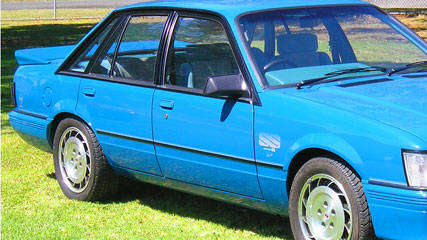Used Holden Commodore review: 1985
By Graham Smith · 14 Jul 2009
Peter Brock’s name will always be synonymous with Holden. The late great driver forged his relationship with Holden with a string of sensational race victories in the 1970s and will forever be remembered as a Holden hero. Never was the bond between Brock and Holden stronger than it was in the early 1980s when Brock set up his own car company and produced a series of race-bred road cars based on the Holden Commodore. There were many great HDT-branded Commodores, but one of the greatest was the ‘Bluey’, the born-to-race Group A Commodore built for the new international Group A racing rules in 1985.MODEL WATCH In 1985 Australia’s touring car racing changed from the home-grown rules that has been in place since the early 1970s to a new formula devised in Europe. The local rules had moved touring car racing away from the street by allowing manufacturers wide ranging freedoms to modify their production cars to suit the track, but the new overseas rules were more restrictive and they reintroduced the requirement to build at least a limited run of production cars to qualify for racing.The VK SS Group A was the first of these so-called ‘homologation’ specials Holden built during the Group A era. It was based on Brock’s HDT SS Commodore, which itself was based on the Commodore SL, the lightest model in the Holden range. All were painted ‘Formula Blue’, hence the nick-name ‘Bluey’ by Brock enthusiasts, and featured a Brock-inspired ‘letter box’ grille and a body kit derived largely from Brock’s previous Commodore racers.Inside it had special blue trim, full instrumentation and a Mono leather steering wheel.Underneath the Group A had a similar suspension set-up to that on Brock’s SS Group Three, with Bilstein gas struts and shocks, and SS springs. Like the regular SS it had a 14 mm rear anti-roll bar, but there was a much heftier 27 mm bar at the front.Brakes were lifted from the Brock SS Group Three, while the wheels were HDT’s 16x7-inch alloys and they were wrapped in Bridgestone Potenza 225/50 rubber.Under the bonnet sat a specially tweaked 4.9-litre Holden V8. Under the Group A rules the Commodore would have been heavily penalised with extra weight had it raced with a regular-sized Holden V8, so the engine’s capacity was reduced from 5.044 litres to 4.987 litres by reducing the stroke to squeak in under the 5.0-litre limit.The rest of the engine drew heavily on Holden’s past racing experience, and included cylinder heads modified by engine guru Ron Harrop, heavier L34 conrods, heavier Chev/L34 valve springs, Crane roller rockers, a lumpy Crane camshaft, Rochester four-barrel carb, matched inlet and exhaust ports, double-row timing chain, lightened flywheel, HM headers, and Lukey mufflers.All up it produced 196 kW at 5200 revs and 418 Nm at 3600 revs, an increase of 19 kW over the regular Holden V8 with equal torque. It was also a more free-revving engine and Holden lifted the red-line by 1000 revs from the standard engine’s limit of 5000 revs. Backing up to the new engine was a stock Holden M21 four-speed manual gearbox.Tested at the time the VK Group A would reach 100 km/h in around seven seconds, and cover the standing 400-metre sprint in 15s. It was quick for its time, handled and stopped exceptionally well, and looked great with an unmistakable Brock road presence.Under the Group A rules Holden had to produce 500 cars before they could race it. These were built on the Holden production line and then shipped to Brock’s factory in Port Melbourne where it was completed.IN THE SHOP Under the Brock skin it’s a Holden Commodore and subject to the same issues that afflict regular Commodores. Under the bonnet look for oil leaks around the engine and power steering. Inside look for wear on the light blue trim as it doesn’t wear well, and check the dash pad for cracks and distortions through exposure to the sun. The good news is that most owners treasure their cars and look after them accordingly. The most important thing is to make sure it’s a genuine Group A model and not a fake.IN A CRASH Safety was in its infancy when the VK Group A was launched, so it lacked the systems now taken for granted. There were no airbags, or ABS, and stability control was still years away from reality. In 1985 cars mostly fell back on body strength and crumple zones, while drivers had to rely on seat belts in a crash. But the VK Group A did have quite good, at least for the time, active safety with its responsive handling and good-sized disc brakes.AT THE PUMP With a highly-tuned V8 under the bonnet the VK Group A is never going to be a fuel-miser, but fuel economy is something few owners would care about. The VK Group A is a sunny Sunday car, it’s not likely to be driven daily, so fuel consumption is of a lesser concern to those who own it. It requires a high-octane fuel, and unless it’s been modified for unleaded it requires an additive. Expect to see economy figures of 15-17 L/100 km, but it depends on driving style.LOOK FOR • Classic Aussie muscle• Brock cred.• Authenticity• V8 performance• Responsive handlingTHE BOTTOM LINE A great Aussie classic muscle car built by a true legend of motorsport.RATING 85/100







